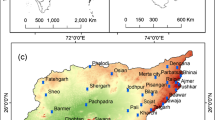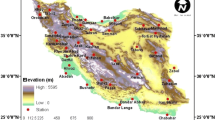Abstract
Drought is considered to be one of the most devastating natural disasters. In recent years, determination of historical droughts has gained more importance. This can be attributed to the fact that once the trend of historical droughts is determined, it should be possible to struggle against drought more effectively. In this study, the drought analysis is performed in the Southeastern Anatolia Project (GAP) region, which is Turkey's biggest integrated project, using the monthly total precipitation data from 15 stations in nine provinces. Standardized precipitation index (SPI), being one of the most frequently used methods in the literature, is used to determine the drought indices. Temporal drought and occurrence of drought are calculated for 3, 6 and 12 month time scales. The non-parametric Mann–Kendall and Mann–Kendall Rank Correlation tests are used to determine the monotonic trends of drought indices and its year of initiation. The “Pre-whitened” method is used to remove serial correlation from time series before analysis. Linear slope of the trend is determined by Sen's Slope method, and Inverse Distance Weighting method is used for the spatial analysis. According to trends of temporal drought of the GAP region, a decreasing trend is found in 30% of the stations for 12-month SPI values with a statistical significance. Based on the results obtained from spatial analysis, there is a decreasing trend in most of the region for almost all time scales, and the slopes of trend are relatively higher in the north and south of the region.






Similar content being viewed by others
References
Agha OMM, Şarlak N (2016) Spatial and temporal patterns of climate variables in Iraq. Arab J Geosci 9:302
Akyürek M (2003) Trend analysis of annual mean streamflows in Turkey. MsC Thesis, Istanbul Technical University
Al-Timimi YK, Al-Jiboori MH (2013) Assessment of spatial and temporal drought in Iraq during the period 1980–2010. Int J Energ Environ 4:291–302
Aydoğdu MH, Sevinç MR, Cançelik M, Doğan HP, Şahin Z (2020) Determination of Farmers’ Willingness to Pay for Sustainable Agricultural Land Use in the GAP-Harran Plain of Turkey Land 9:261
Bahrami M, Bazrkar S, Zarei AR (2019) Modeling, prediction and trend assessment of drought in Iran using standardized precipitation index. J Water Clim Change 10:181–196
Bhunia P, Das P, Maiti R (2020) Meteorological drought study through SPI in three drought prone districts of West Bengal, India. Earth Syst Environ 4:43–55
Bonaccorso B, Bordi I, Cancelliere A, Rossi G, Sutera A (2003) Spatial variability of drought: an analysis of the SPI in Sicily. Water Resour Manag 17:273–296
Caloiero T (2018) SPI trend analysis of New Zealand applying the ITA technique. Geosciences 8:101
Caloiero T, Veltri S, Caloiero P, Frustaci F (2018) Drought analysis in Europe and in the Mediterranean basin using the standardized precipitation index. Water 10:1043
Dabanlı İ, Mishra AK, Şen Z (2017) Long-term spatio-temporal drought variability in Turkey. J Hydrol 552:779–792
Dashtpagerdi MM, Kousari MR, Vagharfard H, Ghonchepour D, Hosseini ME, Ahani H (2015) An investigation of drought magnitude trend during 1975–2005 in arid and semi-arid regions of Iran. Environ Earth Sci 73:1231–1244
Dikici M (2020) Drought analysis with different indices for the Asi Basin (Turkey). Sci Rep 10:1–12
Dirmeyer PA, Brubaker KL (2007) Characterization of the global hydrologic cycle from a back-trajectory analysis of atmospheric water vapor. J Hydrometeorol 8:20–37. https://doi.org/10.1175/JHM557.1
Ebi KL, Bowen K (2016) Extreme events as sources of health vulnerability: drought as an example weather and climate. Extremes 11:95–102. https://doi.org/10.1016/j.wace.2015.10.001
Falzoi S, Acquaotta F, Pulina MA, Fratianni S (2019) Hydrological drought analysis in Continental Temperate and Mediterranean environment during the period 1981–2017. Ital J Agrometeorol 24:13–23. https://doi.org/10.13128/ijam-798
GAP (2021) What’s GAP? http://www.gap.gov.tr/en/. Accessed 25 May 2021
Gemmer M, Becker S, Jiang T (2004) Observed monthly precipitation trends in China 1951–2002. Theor Appl Climatol 77:39–45. https://doi.org/10.1007/s00704-003-0018-3
Gocic M, Trajkovic S (2013) Analysis of changes in meteorological variables using Mann–Kendall and Sen’s slope estimator statistical tests in Serbia. Global Planet Change 100:172–182. https://doi.org/10.1016/j.gloplacha.2012.10.014
Guhathakurta P, Menon P, Inkane P, Krishnan U, Sable S (2017) Trends and variability of meteorological drought over the districts of India using standardized precipitation index. J Earth Syst Sci 126:1–18
Gumus V (2019) Spatio-temporal precipitation and temperature trend analysis of the Seyhan-Ceyhan River Basins, Turkey. Meteorol Appl 26:369–384
Gumus V, Algin HM (2017) Meteorological and hydrological drought analysis of the Seyhan Ceyhan River Basins, Turkey. Meteorol Appl 24:62–73
Helsel DR, Hirsch RM (1992) Statistical methods in water resources, vol 49. Elsevier
Jamro S, Channa FN, Dars GH, Ansari K, Krakauer NY (2020) Exploring the evolution of drought characteristics in Balochistan, Pakistan. Appl Sci 10:913
Kalisa W, Zhang J, Igbawua T, Ujoh F, Ebohon OJ, Namugize JN, Yao F (2020) Spatio-temporal analysis of drought and return periods over the East African region using Standardized Precipitation Index from 1920 to 2016. Agricul Water Manag 237:106195
Karabulut M (2015) Drought analysis in Antakya-Kahramanmaraş Graben. Turkey J Arid Land 7:741–754
Karaca M, Tayanç M, Toros H (1995) Effects of urbanization on climate of İstanbul and Ankara. Atmos Environ 29:3411–3421. https://doi.org/10.1016/1352-2310(95)00085-d
Karanja A (2017) Analysis of temporal drought characteristic using SPI drought index based on rainfall data in Laikipia west sub-county, Kenya. Open Access Lib J 4:1
Kendall MG (1948) Rank correlation methods. Griffin, London, England
Li X et al (2018) Hydrological cycle in the Heihe River Basin and its implication for water resource management in endorheic basins. J Geophys Res: Atmos 123:890–914. https://doi.org/10.1002/2017JD027889
Lloyd-Hughes B, Saunders MA (2002) A drought climatology for Europe. Int J Climatol J R Meteorol Soc 22:1571–1592
Lu GY, Wong DW (2008) An adaptive inverse-distance weighting spatial interpolation technique. Comput Geosci 34:1044–1055
Mann HB (1945) Nonparametric tests against trend. Econometrica: J Econom Soc 13:245–259
McKee TB, Doesken NJ, Kleist J (1993) The relationship of drought frequency and duration to time scales. In: Proceedings of the 8th conference on applied climatology, vol 22, pp 179–183, Boston
Mehr AD, Vaheddoost B (2020) Identification of the trends associated with the SPI and SPEI indices across Ankara, Turkey. Theor Appl Climatol 139:1531–1542
Mohammed S, Alsafadi K, Al-Awadhi T, Sherief Y, Harsanyie E, El Kenawy AM (2020) Space and time variability of meteorological drought in Syria. Acta Geophys 68:1877–1898
Mohsin T, Gough WA (2010) Trend analysis of long-term temperature time series in the Greater Toronto Area (GTA). Theor Appl Climatol 101:311–327
Naz F, Dars GH, Ansari K, Jamro S, Krakauer NY (2020) Drought trends in Balochistan. Water 12:470
Nazmi D, Aydinsakir K, Mesut I, Buyuktas D (2016) Standartlaştırılmış yağış indeksi (SPI) yöntemi ile Antalya ili kuraklık analizi Derim 33:279–298
Oguzturk G, Yildiz O (2014) Drought Analysis for Different Time Periods in the City of Kırıkkale Uluslararası Mühendislik Araştırma Ve Geliştirme Dergisi 6:19–25
Ozguler H, Yildiz D (2020) Consequences of the droughts in the Euphrates-Tigris Basin. Int J Water Manag Diplom 1:29–40
Partal T (2003) Trend analysis in Türkiye precipitation data. MsC Thesis, Istanbul Technical University
Salas JD (1980) Applied modeling of hydrologic time series. Water Resources Publication
Sen PK (1968) Estimates of the regression coefficient based on Kendall’s Tau. J Am Stat as 63:1379–1389
Sharafati A, Nabaei S, Shahid S (2020) Spatial assessment of meteorological drought features over different climate regions in Iran. Int J Climatol 40:1864–1884
Shepard D (1968) A two-dimensional interpolation function for irregularly-spaced data. In: Proceedings of the 1968 23rd ACM National conference, pp 517–524
Sneyers R (1990) On the statistical analysis of series of observations. World Meteorological Organization, Geneva
Soylu N (2021) Southeastern Anatolia Project (Gap) in Turkey and Food Security in the Middle East. Int J Water Manag Diplomacy 1:23–34
Sönmez FK, Koemuescue AU, Erkan A, Turgu E (2005) An analysis of spatial and temporal dimension of drought vulnerability in Turkey using the standardized precipitation index. Nat Hazards 35:243–264
Türkeş M, Tatlı H (2009) Use of the standardized precipitation index (SPI) and a modified SPI for shaping the drought probabilities over Turkey. Int J Climatol: J R Meteorol Soc 29:2270–2282
Umran Komuscu A (1999) Using the SPI to analyze spatial and temporal patterns of drought in Turkey. Drought Network News (1994–2001) 49
Vermes L (1998) How to work out a drought mitigation strategy an ICID Guide guidelines for water management Bonn. DVWK 309:29
Vicente‐Serrano SM et al (2020) Long‐term variability and trends in meteorological droughts in Western Europe (1851–2018). Int J Climatol
Von Storch H (1995) Spatial patterns: EOFs and CCA. In: von Storch H, Navarra A (eds) Analysis of Climate Variability. Springer, New York
Wilhite DA (2000) Drought as a natural hazard: concepts and definitions, vol 1. Drought: A Global Assessment , London
Yenigun K, Ecer R (2013) Overlay mapping trend analysis technique and its application in Euphrates Basin. Turkey Meteorol Appl 20:427–438. https://doi.org/10.1002/met.1304
Yenigun K, Ibrahim WA (2019) Investigation of drought in the northern Iraq region. Meteorol Appl 26:490–499
Yenigün K, Gümüş V, Bulut H (2008) Trends in streamflow of the Euphrates basin, Turkey. Proc Inst Civil Eng Water Manag 161:189–198. https://doi.org/10.1680/wama.2008.161.4.189
Zhang Q, Li J, Singh VP, Bai Y (2012) SPI-based evaluation of drought events in Xinjiang, China. Natl Hazards 64:481–492
Acknowledgements
This study was supported by Harran University Scientific Research Council (HUBAP) with the project number 17177.
Author information
Authors and Affiliations
Corresponding author
Ethics declarations
Competing interest
We declare that we do not have any commercial or associative interest that represents a conflict of interest in connection with the work submitted.
Additional information
Publisher's Note
Springer Nature remains neutral with regard to jurisdictional claims in published maps and institutional affiliations.
Rights and permissions
About this article
Cite this article
Gumus, V., Simsek, O., Avsaroglu, Y. et al. Spatio‐temporal trend analysis of drought in the GAP Region, Turkey. Nat Hazards 109, 1759–1776 (2021). https://doi.org/10.1007/s11069-021-04897-1
Received:
Accepted:
Published:
Issue Date:
DOI: https://doi.org/10.1007/s11069-021-04897-1




